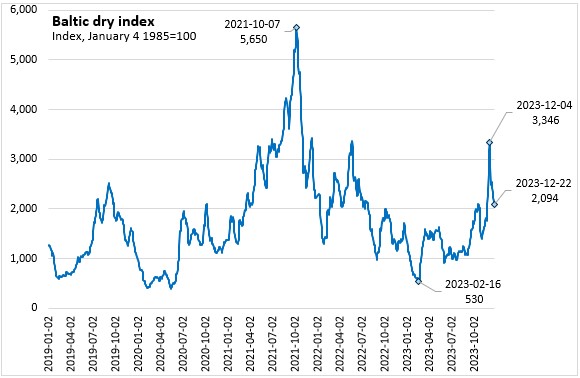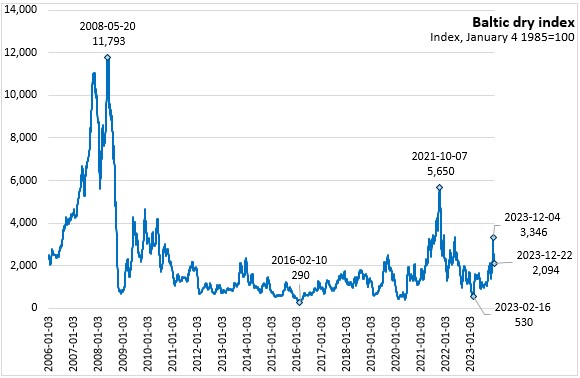The Economics and Statistics Division maintains archives of previous publications for accountability purposes, but makes no updates to keep these documents current with the latest data revisions from Statistics Canada. As a result, information in older documents may not be accurate. Please exercise caution when referring to older documents. For the latest information and historical data, please contact the individual listed to the right.
<--- Return to Archive
For additional information relating to this article, please contact:
December 27, 2023BALTIC DRY INDEX, 2023 The Baltic Dry Index (BDI) measures procurement costs of shipping raw materials by sea.
The BDI recently peaked at a value of 3,346 as of December 4, 2023. In the subsequent weeks, the value of the index has fallen sharply, declining by 37.4% to end the year at a value of 2,094.
In the last three years, the value of the BDI had recently been as low as 530 on February 16, 2023, during sharp monetary tightening. The value of the BDI was recently as high as 5,650 in October 2021 as post-pandemic supply chain problems peaked.

The recent peak of 5,650 in October 2021 was the highest value of the BDI since 2008, but it was less than half of the all-time peak value of 11,793 reported in May 2008. The all-time low of the BDI was a value of 290 reported in February 2016.

Notes: The Baltic Dry Index (BDI) provides a benchmark for the price of moving the major raw materials by sea. It is an index of average prices paid for the transport of dry bulk materials across more than 20 routes. When these costs go down, goods producers benefit from lower shipping costs, and consumers benefit from lower prices for finished products. Higher values indicate more costly shipping, with impacts on costs for goods producers and ultimately for consumer prices. The BDI is often viewed as a leading indicator of economic activity because changes in the index reflect supply and demand for important materials used in manufacturing. The Baltic Dry Index is reported daily by the Baltic Exchange in London.
Sources: Baltic Dry Index Commodities; Bloomberg
<--- Return to Archive